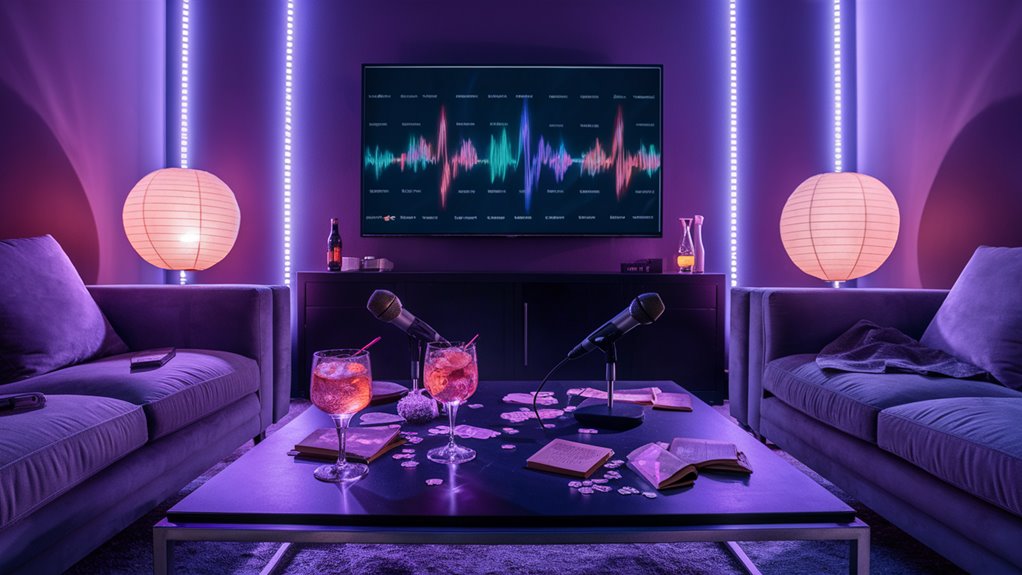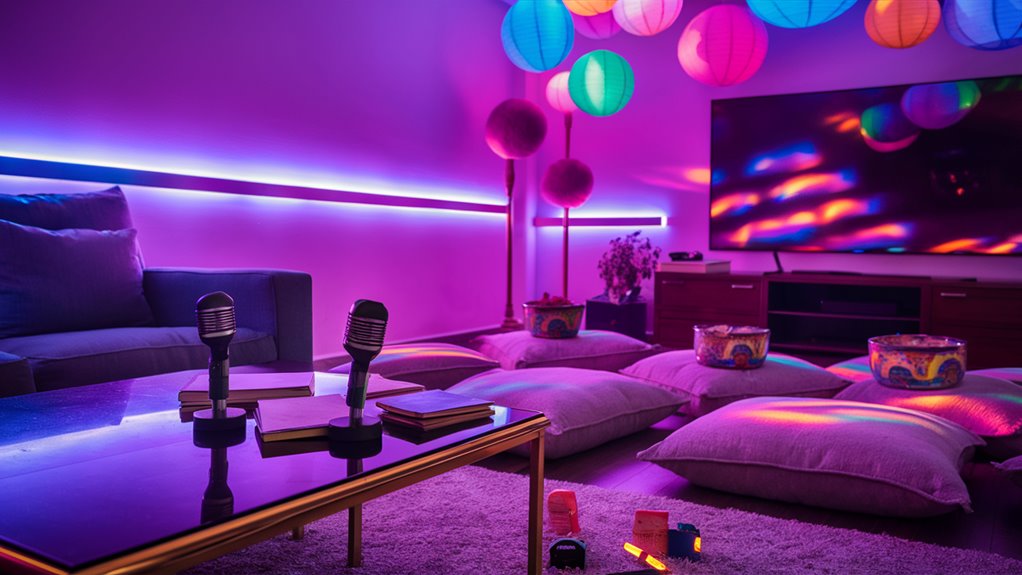
How to Set the Stage for a Fantastic Karaoke Party
Essential Conditions for a Perfect Atmosphere Karaoke
As an experienced entertainer, you know that turning the standard karaoke party into an unforgettable singing experience has five essential elements. Here is how to put them in place.
Carefully Inoffensive Lighting Arrangements
Purposefully arrange your lighting for maximum party mood. Throughout the performance area, install LED strips that can be dimmed, and in the fore an entrance opening with 50% of main room lights lit. Put illumination lamps near the screen to highlight performers and at the same time maintain enough light that people can see lyrics.
Professionally Tuned Sound System
Position your karaoke sound system properly. Speakers should be set at ear level for vertical-aligned, approximately 5-6 feet high normal-sized rooms. Place your screens at standard standing eye-height (6-7 feet) to ensure visual comfort for both singer and audience members.
Comfortable Viewing
Strategic configuration of your seating areas means that a relatively sedentary audience will have no difficulty at all seeing the screen and following what’s happening up there. Ensure there are both sitting and standing areas around the whole venue so people can move naturally from place to place.
Song Playlist Supreme
Use these 40-30-30 rules to create a playlist of songs that keep your guests engaged:
- 40% Current chart-topping hits
- 30% Timeless classics
- 30% Genre-specific favorites
Interactive Entertainment Elements
Add an extra twist of spice to draw your guests’ appetites with original karaoke games:
- Karaoke Roulette – Sing as requested at random
- Theme Teams – Unite cross-genre numbers by era or theme
- Battle Rounds – A little friendly singing competition
Armed with these professional tips, create a convivial atmosphere that keeps your guests singing all night long.
The Perfect Room Setup
A small step to adjust will minimize glare on the screen and maintain the best sight lines for lyrics. Colored lights help identify different performance areas, which is essential in maintaining an atmosphere of cultural exchange.
Optimal Material Arrangement
Set the semicircle row of chairs 8 to 12 feet from your display, and a good view unfolds. This ergonomic combination provides a natural human stage and promotes interaction with the audience. The paths through seating areas and stage locations should be clear to avoid the inconvenience of jumping out onto livestock and other difficulties for performers in transition as well as maintaining smooth flow everywhere around each week’s meetings.
Where to Put Stuff in Meetings
Place the display screen at eyeline level. Stand back and make sure that it falls between your eyes so you do not have to swivel up or down while singing. Put the stereo speakers equidistant from the display, turned slightly inwards for balanced sound.
For At-Home Singers
- Support beverages or materials for song selection
- Personnel preparation area
Planning a Song List
Building Your Core Song Selection
A complete karaoke song catalog laid out strategically is the essential foundation for any karaoke show. Start with songs that everyone’s heard before, such as:
- “Sweet Caroline”
- “Don’t Stop Believin'”
- “I Will Survive”
These songs grab the crowd’s attention and get them to sing along.
Optimal Playlist Distribution
Here are some ideas:
- Hymn One – Getting Out of Hand
- Hymn Two – Maintenance Digest
- Hymn Three – DJ Wives Gossip
- Hymn Four – Dreams The Soul Sleeps
- Hymn Five – CD Player Two
Strategic Song Selection
Maintain dynamism on your list with:
- Variable tempos and moods to avoid monotony
- Duet and group numbers for more social interaction
- Wide vocal ranges to cater to both high and low voices
- 50 to 75 songs in all to avoid bogging down the playlist
Genre Balance and Audience Management
With a mix of current chart-toppers and timeless classics, you can have something that appeals across generations. Include popular sing-along anthems that naturally invite group participation.
Vocal Tally in the Balance
Make sure your playlist contains:
- Low-range songs for bass and baritone singers
- Mid-range choices that are suitable for most people
- High-range choices often suitable for sopranos and tenors
- Songs that everybody can have a go at singing
Sound and Lighting Essentials
Special Audio Arrangements
High-powered sound systems and careful laying out of equipment form the backbone of a premium karaoke environment. A professional-quality speaker system featuring a minimum 300-watt output and dedicated subwoofer ensures maximum power and punch for those very important low tones.
Position audio monitors at ear level, with precise angles towards the stage area for maximum sound coverage and spread.
Microphone Setup
Wireless microphone systems incorporating advanced noise reduction technology produce fine vocal output. Have standby power supplies in place along with thorough tests of equipment before events commence.
Equalizer Setting
Setting the equalizer to zero cuts down on howling problems and enables better voice projection and harmony between sounds.
Advanced Lighting Techniques
- Build on dimmable ambient lighting as your basic foundation
- Use RGB lighting for dynamic color options
- Place spotlights for performance areas
- Incorporate smart lighting for set-specific modes
A Strategy for Refreshments
Strategic Placement of Refreshments
Be sure that a refreshment stand is set up at least 10 feet distant from audio equipment and the stage area to avoid any damage or clutter.

Food Choices for Karaoke Events
Select from these party-friendly options:
- Mini sandwiches and wraps
- Cheese and crackers platter
- Individual appetizers
- Romantic Date Nights
- Pre-packaged snack mix
Avoid messy items like chicken wings or loaded nachos that could harm performance or equipment.
Beverage Station Setup
Set up a separate beverage area apart from the performance arena with:
- Hydration options – Bottled water, sparkling water
- Voice-maintenance liquids – Honey-lemon water, herbal tea
- Mixed cocktail selection – A variety of alcoholic and nonalcoholic drinks
Voice Health Considerations
Appropriate hydration management means longer periods of singing ability. Place water stations throughout the venue to maintain vocal quality.
Clean Space Management
- Napkin stations
- Handwashing stations
Fun Karaoke Games
Interactive Karaoke Party Games
By playing these party games, everyone has a good time singing and laughing throughout the evening.
Classic Karaoke Party Games
- Karaoke Roulette – Singers draw songs at random
- Theme Teams – Divide singers into groups like pop vs. country
Dynamic Group Activities
- Musical Hot Potato – Singing moves from person to person
- Duet Challenge – Randomly paired singers perform together
- Live Audience Poll – The audience votes in real time for songs
Other Entertainment Innovations
- Prop Box – Singers use props and costumes for added entertainment
- Change of Style – Participants sing songs in different genres
- Puzzle Lyrics – Contestants fill in missing lyrics while singing
- Speed Round – Sing as many snippets as possible in 30 seconds
These interactive karaoke games ensure everyone stays engaged and leaves with unforgettable memories.


